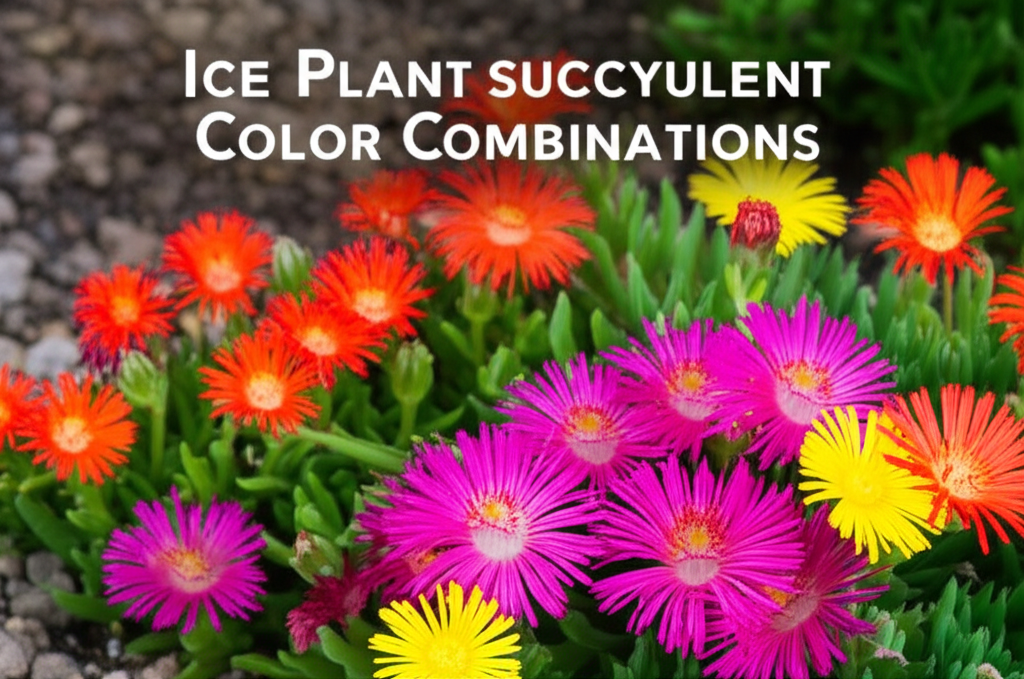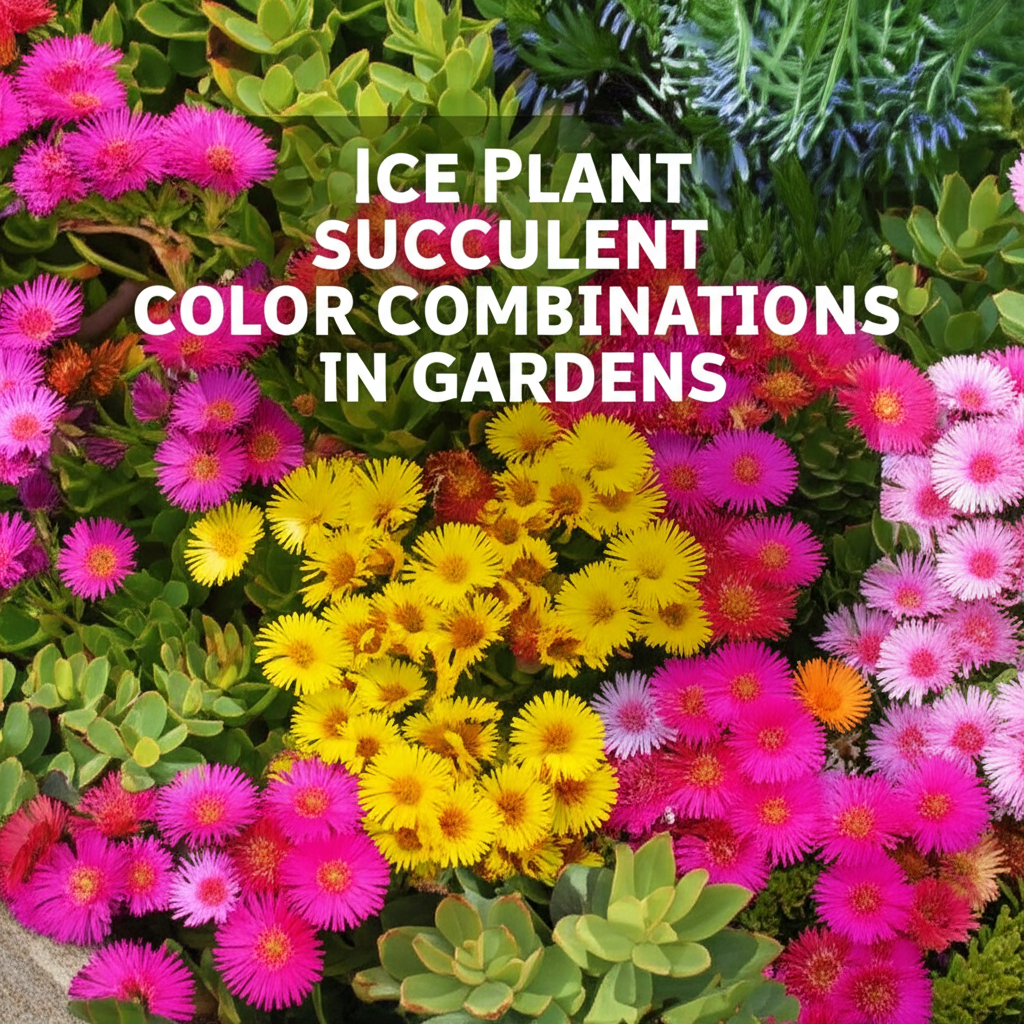Introduction: The Mesmerizing Allure of Ice Plant Succulents
Ice plant succulents, scientifically known as Delosperma, are a vibrant and diverse group of flowering groundcovers that have taken the gardening world by storm. Renowned for their daisy-like flowers that bloom profusely throughout the summer months, these low-growing, drought-tolerant beauties offer a spectacular splash of color in even the most challenging garden conditions. Their unique succulent leaves, often plump and filled with water, give them an almost “frosted” appearance, hence their common name.
What truly sets ice plants apart is their astonishing array of flower colors. From fiery oranges and brilliant reds to soft pinks, vibrant purples, sunny yellows, and pristine whites, the Delosperma genus provides a painter’s palette for garden designers and enthusiasts alike. Successfully combining these dazzling hues can transform a simple landscape into a breathtaking tapestry of color and texture. This article will delve into the art and science of creating stunning ice plant succulent color combinations, exploring key principles, practical advice, and inspiring ideas to elevate your garden’s aesthetic appeal.
Understanding Ice Plant Succulent Varieties and Their Colors

Before embarking on color combinations, it’s crucial to understand the diversity within the Delosperma family. While many share similar growth habits, their color palettes can vary significantly.
Key Ice Plant Varieties and Their Signature Hues
- Delosperma cooperi: Often referred to as Cooper’s Ice Plant, this is one of the most popular and widely available varieties. It typically produces vibrant magenta or deep pink flowers with a contrasting yellow eye. It’s a reliable bloomer and a fantastic choice for beginners.
- Delosperma dyeri: Known for its striking, fiery orange-red flowers, D. dyeri is a showstopper. It often has a slightly more upright growth habit than some of its relatives and demands excellent drainage.
- Delosperma nubigenum: This variety is celebrated for its cheerful, bright yellow flowers. It forms a dense, mat-forming groundcover and is particularly effective cascading over walls or containers.
- Delosperma ‘Jewel of Desert’ Series: This popular hybrid series offers an incredible spectrum of colors, including amethyst purple, ruby red, topaz yellow, sapphire blue, and rose pink. These cultivars are often more compact and produce exceptionally large, vibrant flowers.
- Delosperma ‘Hot Pink’: As the name suggests, this cultivar boasts intensely saturated hot pink blooms, providing a bold and impactful visual statement.
- Delosperma ‘Sunburst’: This variety features a unique bi-color effect, often with orange outer petals and a yellow center, or vice-versa, creating a sun-kissed appearance.
- Delosperma ‘Alan’s Rainbow’: A less common but highly sought-after variety, known for its foliage that can exhibit a range of colors from green to purple and pink, often complemented by purple flowers.
A Comparative Look at Popular Ice Plant Colors
To better visualize the potential for color combinations, consider this table:
| Variety/Series | Primary Flower Color(s) | Secondary Color/Eye | Growth Habit | Notes |
|---|---|---|---|---|
| Delosperma cooperi | Magenta/Deep Pink | Yellow | Mat-forming groundcover | Hardy and widely available |
| Delosperma dyeri | Fiery Orange-Red | Yellow | Low-growing, dense | Requires excellent drainage |
| Delosperma nubigenum | Bright Yellow | Yellow | Dense, mat-forming | Excellent for rock gardens |
| ‘Jewel of Desert’ Amethyst | Amethyst Purple | Yellow | Compact | Large flowers |
| ‘Jewel of Desert’ Ruby | Ruby Red | Yellow | Compact | Intense coloration |
| ‘Jewel of Desert’ Topaz | Topaz Yellow | Yellow | Compact | Bright, sunny blooms |
| ‘Hot Pink’ | Hot Pink | Yellow | Low-growing | Bold, vibrant color |
Color Theory Principles for Ice Plant Combinations
Effective color combinations in the garden, just like in art, rely on fundamental principles of color theory. Understanding these principles will help you create harmonious and visually appealing displays with your ice plants.
Monochromatic Schemes: Subtle Elegance
Monochromatic schemes involve using variations of a single color. For ice plants, this could mean combining different shades of pink, purple, or yellow.
- Example: Shades of Pink: Pair Delosperma cooperi (magenta) with a softer rose-pink cultivar. The subtle differences in hue create depth and interest without being overwhelming.
- Example: Tonal Yellows: Combine Delosperma nubigenum (bright yellow) with a cultivar that has a softer, buttery yellow bloom. This creates a gentle, sunny effect.
Analogous Schemes: Harmonious Blends
Analogous schemes use colors that are adjacent to each other on the color wheel. These combinations tend to be pleasing to the eye and create a sense of harmony.
- Example: Pinks and Purples: Combine magenta Delosperma cooperi with amethyst purple ‘Jewel of Desert’ varieties. The transition between these colors is smooth and natural.
- Example: Yellows and Oranges: Pair bright yellow Delosperma nubigenum with fiery orange-red Delosperma dyeri. This creates a warm, vibrant, and energetic display.
Complementary Schemes: Bold Contrast
Complementary colors are opposite each other on the color wheel. When placed next to each other, they create the strongest contrast and the most vibrant visual impact.
- Example: Purple and Yellow: A classic pairing. Combine amethyst purple ‘Jewel of Desert’ varieties with bright yellow Delosperma nubigenum. This combination is exceptionally eye-catching and dynamic.
- Example: Orange and Blue (Subtle): While true blue ice plants are rare, some purples can lean towards a bluish tone. Pairing these with orange varieties like D. dyeri can create a striking, though slightly more subtle, complementary effect.
Triadic Schemes: Vibrant and Balanced
Triadic schemes use three colors that are evenly spaced on the color wheel. These can be very vibrant and lively.
- Example: Yellow, Pink, and Orange: Combine bright yellow Delosperma nubigenum, magenta Delosperma cooperi, and fiery orange-red Delosperma dyeri. This creates a bold and cheerful statement, ideal for sunny locations.
Practical Tips for Creating Stunning Ice Plant Combinations
Beyond color theory, several practical considerations will ensure your ice plant displays are not only beautiful but also successful.
1. Consider Bloom Time and Duration
While many ice plants bloom throughout the summer, some may have slightly different peak bloom times. Mixing varieties with overlapping bloom periods will ensure continuous color.
2. Factor in Foliage Color and Texture
Don’t forget the foliage! Some ice plants, like ‘Alan’s Rainbow’, offer interesting foliage colors that can complement the flowers. The plump, succulent leaves themselves provide a unique texture that contrasts well with other garden plants.
3. Site Conditions Matter
Ice plants thrive in full sun and require well-draining soil. Ensure your chosen planting location meets these needs. Poor drainage is the most common reason for ice plant failure.
4. Scale and Proportion
Consider the overall scale of your garden and the mature size of the ice plant varieties you choose. Taller, more vigorous varieties might be better suited for borders or slopes, while compact types are excellent for rock gardens or containers.
5. Companion Planting
Ice plants don’t have to stand alone. Their drought-tolerant nature and bright flowers make them excellent companions for other xeric-loving plants.
- Herbs: Thyme, lavender, and rosemary are excellent companions, offering fragrance and complementary textures.
- Ornamental Grasses: Fine-textured grasses can provide a soft, airy contrast to the dense blooms of ice plants.
- Other Succulents: Sedums, sempervivums (hens and chicks), and echeverias can create a cohesive succulent garden.
Inspiring Ice Plant Combination Ideas
Let’s get creative with some specific color combination examples:
1. The Fiery Sunset Garden
- Primary Plants: Delosperma dyeri (fiery orange-red), Delosperma nubigenum (bright yellow).
- Accents: ‘Jewel of Desert’ Topaz (yellow) for more intense yellow, a touch of red-tinged foliage succulent for contrast.
- Companion Plants: Red creeping sedum, golden creeping Jenny, ornamental grasses with bronze tones.
- Effect: A warm, energetic display that mimics the vibrant colors of a sunset. Best in a sunny, prominent location.
2. The Cool Oasis Blend
- Primary Plants: Amethyst purple ‘Jewel of Desert’ varieties, Delosperma cooperi (magenta).
- Accents: A rarer cultivar with softer lavender blooms, silvery-leaved succulents.
- Companion Plants: Blue fescue grass, lavender, creeping thyme with purple flowers.
- Effect: A serene and sophisticated combination that uses cooler tones. Creates a calming atmosphere, particularly in contrast to warmer colors elsewhere in the garden.
3. The Jewel Box Explosion
- Primary Plants: A mix of ‘Jewel of Desert’ series: Ruby (red), Amethyst (purple), Topaz (yellow), and Sapphire (blue-ish purple).
- Accents: ‘Hot Pink’ for a vibrant punch, white-flowering ice plant for contrast.
- Companion Plants: Silver mound artemisia, low-growing blue-flowering campanula, white alyssum.
- Effect: A high-impact, celebratory display of diverse colors. This works best when you want a show-stopping focal point.
4. The Subtle Gradient
- Primary Plants: Delosperma cooperi (magenta), a softer pink ice plant variety, and Delosperma nubigenum (bright yellow).
- Accents: White ice plant or white-flowering sedum.
- Companion Plants: Dusty miller, lamb’s ear (for silvery foliage), pale green ornamental sedums.
- Effect**: A gentle and harmonious progression of color, creating visual flow and depth. This is a safe and elegant choice that is always pleasing to the eye.
Cultivation and Care for Optimal Color
To ensure your ice plants display their most vibrant colors, proper care is essential.
Key Steps for Thriving Ice Plants
This table outlines essential care practices:
| Step | Description | Importance for Color |
|---|---|---|
| Planting Location | Full sun (at least 6-8 hours per day). | Essential for robust flowering and vibrant color. Insufficient sun leads to sparse blooms. |
| Soil Preparation | Well-draining soil is paramount. Amend heavy clay soils with grit, sand, or perlite. | Prevents root rot, which weakens the plant and reduces flowering. |
| Watering | Water thoroughly when the soil is dry to the touch. Avoid overwatering, especially in cooler months. | Healthy hydration promotes strong growth and blooming. |
| Fertilizing | Generally not required. If desired, use a diluted, balanced liquid fertilizer sparingly in spring. | Over-fertilizing can lead to excessive foliage growth at the expense of flowers. |
| Pruning | Trim back leggy growth after flowering to encourage bushier habit and more blooms. | Promotes dense growth and stimulates new flower buds. |
| Winter Care | In colder climates (Zone 5-6), provide winter protection such as a layer of mulch or bring potted plants indoors. | Protecting the roots ensures the plant survives to bloom the following year. |
Pros and Cons of Ice Plant Combinations
When planning your garden, consider the advantages and potential drawbacks of using multiple ice plant colors.
| Pros | Cons |
|---|---|
| Vibrant, Long-Lasting Blooms: Provide color from late spring through fall. | Susceptible to Overwatering: Requires excellent drainage; can lead to root rot. |
| Drought-Tolerant: Ideal for water-wise gardens and hot, dry climates. | Limited Cold Hardiness: Many varieties are best suited for warmer climates (Zones 6+). |
| Low Maintenance: Once established, require minimal care. | Can Spread Aggressively: Some varieties may need occasional containment. |
| Attracts Pollinators: Bees and butterflies are drawn to their nectar-rich flowers. | Foliage Can Be Delicate: Can be damaged by heavy frost or hail. |
| Versatile Groundcover: Excellent for borders, rock gardens, slopes, and containers. | Color Availability Can Vary: Specific cultivars might be harder to find seasonally. |
Conclusion: Painting Your Garden with Ice Plant Colors
Ice plant succulents offer an unparalleled opportunity to infuse your garden with dazzling color and resilient beauty. By understanding the diverse palette of Delosperma varieties and applying the principles of color theory, you can create dynamic and harmonious displays that will captivate the eye. Whether you opt for subtle monochromatic blends, vibrant complementary pairings, or adventurous triadic schemes, the key lies in thoughtful planning and attentive care.
Remember to consider site conditions, bloom times, and companion plants to ensure your ice plant combinations not only look spectacular but also thrive. With their low-maintenance nature and remarkable ability to bloom prolifically, ice plants are a rewarding choice for any gardener seeking to add a touch of brilliance and enduring color to their outdoor spaces. Embrace the artistry of color and let your ice plant succulents transform your garden into a masterpiece.


